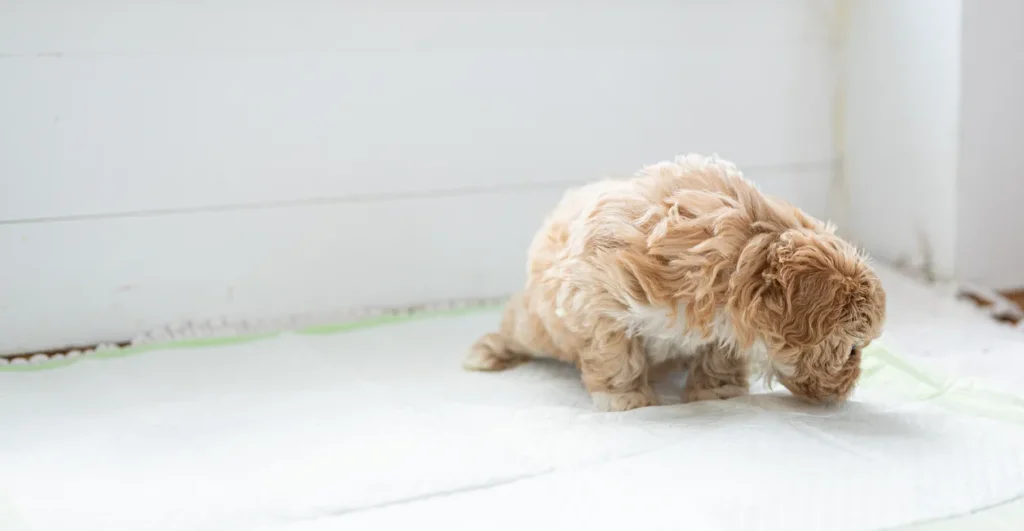Potty training a puppy can be a daunting task. Never is there a more appropriate time to call yourself a pet parent. Potty training a puppy requires a lot of you as well as your puppy.
In order to successfully potty train a puppy you will have to establish a schedule for their eating and potty breaks. You must also be very consistent with the schedule and your own behavior. That can be much more easily said than done!
Let’s take a look at how to potty train a puppy and some tips and tricks that will help you along the way.

You can begin to potty train your puppy when it reaches three to four months of age. If by circumstance you must start later than this, the puppy may have already established bad habits that you have to address, and training them may take longer.
It usually takes about six months to potty train a puppy. However, some dogs may take as long as a year before they are fully potty trained.
The whole purpose of potty training is to get your puppy to use the bathroom outside. You will need to feed them on schedule and take them out on schedule to make this work.
Additionally, you will need to recognize the signs that the puppy needs to go to the bathroom so that you can take them outside. Common signs include barking, whining, and either scratching at the door or their cage or crate door.
You can use a crate to help potty train your puppy, but this doesn’t work for everyone or every puppy. Some people don’t like the idea of crate training and that is okay, too.
If you want to use a crate to help train your puppy, here are some important things to consider:
It would be nice if puppies taught themselves to go outside, but they just don’t. However, there are some hints and tips that may help.
As is true of so many things when raising a puppy, you must have patience. It is not unusual for a dog to have accidents for the first year of its life and even after that when its routine is disturbed or there is other upset.
If potty training just isn’t working or if you have a dramatic setback you should consult a veterinarian.
From the moment you walk in the door with your precious new puppy, a strange and wonderful journey begins of long walks in the park, tossing sticks in the backyard, and potty training. Puppy potty training is perhaps the greatest test of the bond between humans and canines. However, the fact that there are millions of potty-trained puppies in the world means that, despite being challenging, it can be done.

The good news is that there are tips and tricks for every puppy training problem you could ever possibly encounter. To begin, adopt a proactive mindset that includes:
From there, you make a potty training plan that sets your puppy up for success and fits your lifestyle. There are many reliable methods for house training your puppy that can be tweaked to fit your needs. The most popular methods are crate training and paper training.
Although it might seem cringy at first, confining your puppy to a crate makes puppy potty training a whole lot easier. As den animals, puppies feel more secure in small, enclosed spaces like the maternal dens their mothers make for their litters. The way crate training works is by relying on your puppy's hygienic nature to inhibit them from soiling the space that they lie in. The crate should be just large enough for your puppy to lie down, stand up, and turn around. Make sure to let them out for potty breaks at regular intervals as puppies can only hold their bladders for one hour for every month of age up to about nine months old. Your puppy should also alert you when they have to come out to potty by whining, barking, or scratching. Then all you have to do is take your puppy outside on a leash without delay to their designated bathroom spot.
Some people find that paper training can be a little confusing for their puppy because it gives them two behavior options to choose from. However, paper training is a convenient choice for puppy parents during bitterly cold weather or when they have to leave for several hours. Paper training provides an approved spot for your puppy to go potty in the house. When combined with crate training, lead your puppy to their potty paper at regular intervals, such as first thing in the morning, after meals or drinking, and after naps, along with giving them a treat and praise when they use the approved spot should help them understand where the potty goes.
At some point on this puppy potty training journey, you may find yourself fuming over your once-favorite, now-ruined rug with steam rolling out of your ears. At that moment, close your eyes, take a deep breath and know that you and your puppy will get through this phase. All too soon, your precious puppy's whiskers will turn gray, their tail will droop, and they won't be able to jump onto the bed without help. Then you'll look back on all the joy and love they have given over the years, and you will miss this.
Phone: (855) 461-8259
Email: [email protected]